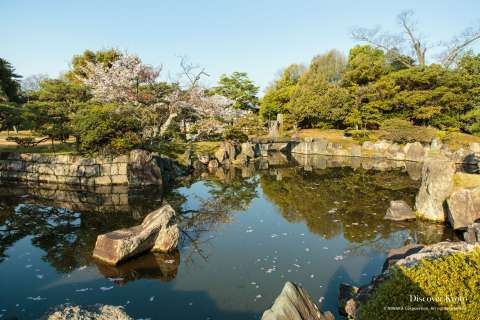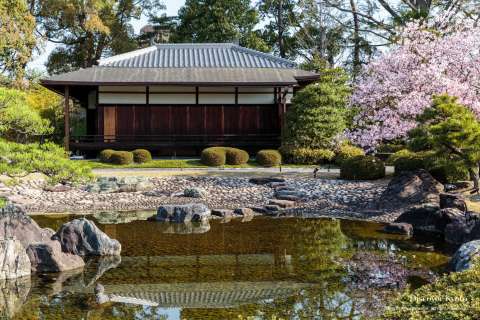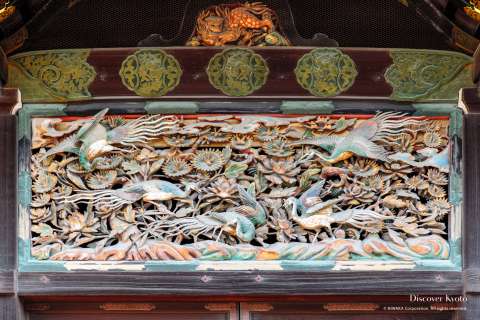Nijō-jō|二条城
Overview

Known as the Kyoto residence of the famous leader Tokugawa Ieyasu (the first shogun of the Edo Period), Nijō Castle is a stronghold that represents the prestige and power of the mighty leader known as the unifier of Japan. Construction on the castle was begun in 1601 and finished 25 years later by Ieyasu’s grandson Iemitsu. In 1939, the castle was donated to the city of Kyoto and was officially opened to the public. Enjoy exploring and learning about Ieyasu’s dramatic and interesting life - no one said history had to be boring! With hundreds of varieties of flora as well, Nijō-jō is also a great place to view some of Japan’s treasured seasonal beauty.
Nijō Castle is a stronghold that represents the prestige and power of the mighty leader known as the unifier of Japan.
Features
Karamon

Before you enter the Ninomaru Palace you are greeted by the Karamon, a “Chinese-style” gate identified by its use of karahafu, a curved gable particular to Japan (despite the “Chinese” in its name). This gate is a popular photo spot with tourists, and considering how iconic it is, it’s easy to see why the impressive entrance draws a lot of attention. The gate has earned a reputation for its gorgeous woodcarvings, covered in beautiful detailing that must have taken artisans of old countless hours to create.
Ninomaru Palace

The Ninomaru Palace has five buildings, 33 rooms, and 800 tatami mats (straw mats), and is mostly constructed of hinoki cypress. On the front you will see Luan birds (a type of mythical Chinese bird), pine trees, clouds, grass and peonies. The base is made out of squared masonry, and the roof uses cypress bark. The palace was an office and residence for the Tokugawa Shoguns when they visited Kyoto, and so it was constructed to reflect the power of the office. Each room in the palace was designed by great artists of the Kanō school, and the woodwork and painted screens are particularly superb. The floors of the corridor are called uguisubari (nightingale floors) on account of the construction that makes them squeak when stepped upon.
The rooms in the palace can also be used to understand the history of the castle itself as well as the political situation in society at that time. For example, though the Shogun held the real political power, he still put on the act of being beneath the emperor in power. In the Chokushi no Ma, a room where the shogun and messengers from the court would meet, you can see that the messengers would sit at the elevated upper end of the room while the shogun would sit on the lower side, showing deference to the representatives of Kyoto’s imperial court.
Ninomaru Garden

Just outside the Ninomaru Palace is the lovely strolling garden titled simply as “The Ninomaru Garden”. The Ninomaru Garden was designed by famous landscape architect and tea master Kobori Enshū (1579-1647). The garden is constructed around a large central pond decorated with a variety of stones of all shapes and sizes, and the pond also has three islands: Hōrai-jima (Island of Eternal Happiness), Tsuru-jima (Crane Island) and Kame-jima (Turtle Island). In 2006, the American magazine Journal of Japanese Gardening ranked Ninomaru Garden eigth out of 731 gardens all over Japan.
Honmaru

The Honmaru is the 20,000 square meter area surrounded by the inner moat, featuring a garden and palace. When it was first built, boasting beautiful rooms designed by the Kanō School, the Honmaru Palace was very similar to the Ninomaru Palace. However, due to a fire caused by a lightning strike in 1750 and the great fire in 1788, the Honmaru Palace and the five story castle keep was destroyed. The current building was transferred from the Kyoto Imperial Palace in 1893 after the fall of the shogunate to serve at Nijō Castle. Though not usually open to the public, there are special viewings in the fall where people can view inside this new Honmaru. The Honmaru complex garden is constructed in a “hill and grass” style. Designed in 1896, it took seven and half months to transform the garden from its original dry-landscape style.
Seiryū-en

The spacious Nijō Castle complex also boasts a half-Western and half-Japanese style garden called the Seiryū-en. The name “Seiryū-en” was given by Kyoto’s mayor at the time, Yoshizō Takayama. The garden was built in 1965 for cultural events such as tea ceremonies and as a facility for the reception of official guests of the city. Walking through the 16,500 square-meter complex you will find two tea houses, over 1,000 stones, a pond, and more. The Seiryū-en is a gorgeous place where you can stroll for as long as you like, admiring and taking countless photos.
Trees & Flowers

The Nijō Castle complex is home to a variety of flowers and trees. Depending on the season you visit there will surely be a different seasonal bloom greeting you upon your arrival.
Camellia (Tsubaki)
It’s believed there are 400 tsubaki of approximately 90 different varieties at Nijō Castle today. The tsubaki trees were planted in 1953. The season for tsubaki starts in December and finishes around mid-April. Tsubaki flowers hold cultural significance in Japan and have been the focus of a number of rituals and beliefs, as well as being used in beauty products.
Japanese Plum (Ume)
Just before the sakura (cherry blossoms) come out to play, the ume flowers blossom around Kyoto, brightening up the city. The ume at Nijō Castle were planted in 1954 and there are over 130 trees at the castle. The variety of ume include; shiraume, momoiroume, benichidori, shidareume, and many more. Ume season at Nijō Castle usually starts from early February to late March.
Spike Winter Hazel (Tosamizuki)
The tosamizuki at Nijō Castle blooms around the same time as the ume flowers. Tosamizuki is a deciduous shrub that hails from Kōchi Prefecture. It is popularly used for bonsai (a Japanese art form that involves the creation and care of miniature garden trees).
Cherry Blossoms (Sakura)
No doubt Japan’s most beloved flower, there are 400 sakura trees of 50 varieties at Nijō Castle. During March and April, people from all over the country and world come to Kyoto to view these beautiful trees. The majority of the sakura were planted from late 1955 until early 1965. Nijō Castle is one of the famous places people visit during the season, and the best time to view the sakura is late March to early April. Please note that the period is subject to change due to climate.
History
As a seat of power for the Tokugawa shogunate within the capital that used to be ruled solely by the Emperor, Nijō-jō was designed from the beginning to be a grandiose reminder of Japan’s new power structure. When Tokugawa Ieyasu, first lord of the Tokugawa Shogunate, began consolidating his power in 1601 after the decisive Battle of Sekigahara, he ordered all feudal lords loyal to him to contribute to the building effort. Already in his late 60’s, Ieyasu did not survive to see Nijō Castle to its completion, but in 1626 it was finished under the reign of his grandson and third Shogun, Tokugawa Iemitsu.
Though the Tokugawa Shogunate used Edo (now Tokyo) as their capital city, Kyoto was the home of the Imperial Court, and so the Shogun would stay at Nijō Castle during his official visits. However, it was no accident that the Shogun’s castle was designed to be as large as it was and placed close to the Imperial Palace! In 1788, Nijō Castle was partially destroyed in a large fire that swept through Kyoto, but the burned portions were eventually replaced by a residence transferred from the Imperial Palace grounds in 1893.
Nijō-jō served the Tokugawa Shogunate for almost 250 years until 1867 when the 15th and final Tokugawa Shogun, Tokugawa Yoshinobu, took the floor in Nijō Castle’s Ninomaru Palace to declare authority over the country would return to the Imperial Court and Emperor Meiji. Once that decree was issued the Imperial Court took over the property and based Cabinet activities within the castle, removing the Tokugawa hollyhock seals and replacing them with imperial chrysanthemums.
The castle was donated to Kyoto City in 1939, and in 1940 it opened its doors to the public, remaining to this day a historical landmark that serves as proof of the rise and fall of the Tokugawa Shogunate.
Events
March – April | Cherry Blossom Illumination |
|---|---|
April | Cherry Blossom Viewing Tea Ceremony |
May | Kyoto Citizens Sencha Tea Ceremony |
October, November | Kyoto Citizens Grand Tea Ceremony |
October – December | Nijō Castle Festival |
Access
Address
〒604-8301 Kyoto, Nakagyō-ku, Nijō-dōri Horikawa Nishi Iru, Nijōjō-chō 541
| TEL | 075-841-0096 |
| FAX | 075-802-6181 |
| WEB | http://nijo-jocastle.city.kyoto.lg.jp/?lang=en |
Admission
- General Admission: ¥620 (castle grounds), ¥1,030 (castle grounds and Ninomaru Palace)
- Junior High School, High School Students: ¥350 (castle grounds and Ninomaru Palace)
- Primary School Students: ¥200 (castle grounds and Ninomaru Palace)
Hours
- Nijō Castle
- General Admission: 8:45 – 16:00 (the castle closes at 17:00; hours may change depending on the season)
- Closed: December 29th–31st
- Ninomaru Palace
- General Admission: 8:45 – 16:10 (hours may change depending on the season)
- Closed: December 26th – January 3rd, each Tuesday in January, July, August and December*
- *When Tuesday falls on a public holiday, the palace is closed the following day instead.
- Parking
- Car Parking: ¥1,050 for the first 2 hours plus ¥200 for every extra hour (Parking Lot 1); ¥800 for the first 2 hours plus ¥200 for every extra hour (Parking Lot 3)
- Motorcycle Parking: ¥400 for the first 2 hours plus ¥200 for every extra hour
- Bicycle Parking: ¥200 for the first 2 hours plus ¥100 for every extra hour
Transportation
Gallery
-




 +28
+28
